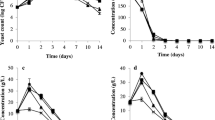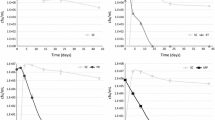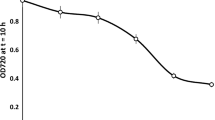Abstract
Volatile compounds produced by yeast during fermentation greatly influence the organoleptic qualities of wine. We developed a model to predict the combined effects of initial nitrogen and phytosterol content and fermentation temperature on the production of volatile compounds. We used a Box–Behnken design and response surface modeling to study the response of Lalvin EC1118® to these environmental conditions. Initial nitrogen content had the greatest influence on most compounds; however, there were differences in the value of fermentation parameters required for the maximal production of the various compounds. Fermentation parameters affected differently the production of isobutanol and isoamyl alcohol, although their synthesis involve the same enzymes and intermediate. We found differences in regulation of the synthesis of acetates of higher alcohols and ethyl esters, suggesting that fatty acid availability is the main factor influencing the synthesis of ethyl esters whereas the production of acetates depends on the activity of alcohol acetyltransferases. We also evaluated the effect of temperature on the total production of three esters by determining gas–liquid balances. Evaporation largely accounted for the effect of temperature on the accumulation of esters in liquid. Nonetheless, the metabolism of isoamyl acetate and ethyl octanoate was significantly affected by this parameter. We extended this study to other strains. Environmental parameters had a similar effect on aroma production in most strains. Nevertheless, the regulation of the synthesis of fermentative aromas was atypical in two strains: Lalvin K1M® and Affinity™ ECA5, which produces a high amount of aromatic compounds and was obtained by experimental evolution.





Similar content being viewed by others
References
Barbosa C, Mendes-Faia A, Mendes-Ferreira A (2012) The nitrogen source impacts major volatile compounds released by Saccharomyces cerevisiae during alcoholic fermentation. Int J Food Microbiol 160:87–93
Bell SJ, Henschke PA (2005) Implications of nitrogen nutrition for grapes, fermentation and wine. Aust J Grape Wine Res 11:242–295
Beltran G, Esteve-Zarzoso B, Rozes N, Mas A, Guillamon JM (2005) Influence of the timing of nitrogen additions during synthetic grape must fermentations on fermentation kinetics and nitrogen consumption. J Agric Food Chem 53:996–1002
Beltran G, Novo M, Leberre V, Sokol S, Labourdette D, Guillamon JM, Mas A, François J, Rozes N (2006) Integration of transcriptomic and metabolic analyses for understanding the global responses of low-temperature winemaking fermentations. FEMS Yeast Res 6:1167–1183
Bely M, Sablayrolles JM, Barre P (1990) Automatic detection of assimilable nitrogen deficiencies during alcoholic fermentation in enological conditions. J Ferment Bioeng 70:246–252
Blanco P, Mirás-Avalos JM, Pereira E, Orriols I (2013) Fermentative aroma compounds and sensory profiles of Godello and Albariño wines as influenced by Saccharomyces cerevisiae yeast strains. J Sci Food Agric 93:2849–2857
Blateyron L, Sablayrolles JM (2001) Stuck and slow fermentations in enology: statistical study of causes and effectiveness of combined additions of oxygen and diammonium phosphate. J Biosci Bioeng 91:184–189
Boulton RB, Singleton VL, Bisson LF, Kunkee RE (1995) Principles and practices of winemaking. Champman & Hall, New York
Box GEP, Behnken DW (1960) Some new three level designs for the study of quantitative variables. Technometrics 2:455–475
Cadière A, Ortiz-Julien A, Camarasa C, Dequin S (2011) Evolutionary engineered Saccharomyces cerevisiae wine yeast strains with increased in vivo flux through the pentose phosphate pathway. Metab Eng 13:263–271
Cadière A, Aguera E, Caillé S, Ortiz-Julien A, Dequin S (2012) Pilot-scale evaluation the enological traits of a novel, aromatic wine yeast strain obtained by adaptive evolution. Food Microbiol 32:332–337
Camarasa C, Grivet JP, Dequin S (2003) Investigation by 13C-NMR and tricarboxylic acid (TCA) deletion mutant analysis of pathways for succinate formation in Saccharomyces cerevisiae during anaerobic fermentation. Microbiology 149:2669–2678
Camarasa C, Sanchez I, Brial P, Bigey F, Dequin S (2011) Phenotypic landscape of Saccharomyces cerevisiae during wine fermentation: evidence for origin-dependent metabolic traits. PLoS One 6:e25147
Carrau FM, Medina K, Farina L, Boido E, Henschke PA, Dellacassa E (2008) Production of fermentation aroma compounds by Saccharomyces cerevisiae wine yeasts: effects of yeast assimilable nitrogen on two model strains. FEMS Yeast Res 8:1196–1207
Chirala SS (1992) Coordinated regulation and inositol-mediated and fatty acid-mediated repression of fatty acid synthase genes in Saccharomyces cerevisiae. Proc Natl Acad Sci 89:10232–10236
Clement T, Perez M, Mouret JR, Sanchez I, Sablayrolles JM, Camarasa C (2013) Metabolic responses of Saccharomyces cerevisiae to valine and ammonium pulses during four-stage continuous wine fermentations. Appl Environ Microbiol 79:2749–2758
Colombie S, Malherbe S, Sablayrolles JM (2005) Modeling alcoholic fermentation in enological conditions: feasibility and interest. Am J Enol Vitic 56:238–245
Crépin L, Nidelet T, Sanchez I, Dequin S, Camarasa C (2012) Sequential use of nitrogen compounds by Saccharomyces cerevisiae during wine fermentation: a model based on kinetic and regulation characteristics of nitrogen permeases. Appl Environ Microbiol 78:8102–8111
Fujii T, Kobayashi O, Yoshimoto H, Furukawa S, Tamai Y (1997) Effect of aeration and unsaturated fatty acids on expression of the Saccharomyces cerevisiae alcohol acetyltransferase gene. Appl Environ Microbiol 63:910–915
Garde-Cerdán T, Ancín-Azpilicueta C (2008) Effect of the addition of different quantities of amino acids to nitrogen-deficient must on the formation of esters, alcohols, and acids during wine alcoholic fermentation. LWT Food Sci Technol 41:501–510
Hazelwood LA, Daran JM, van Maris AJA, Pronk JT, Dickinson JR (2008) The Ehrlich pathway for fusel alcohol production: a century of research on Saccharomyces cerevisiae metabolism. Appl Environ Microbiol 74:3920
Hernandez-Orte P, Bely M, Cacho J, Ferreira V (2006) Impact of ammonium additions on volatile acidity, ethanol, and aromatic compound production by different Saccharomyces cerevisiae strains during fermentation in controlled synthetic media. Aust J Grape Wine Res 12:150–160
Husson F, Josse J, Le S, Mazet J (2012) FactoMineR: multivariate exploratory data analysis and data mining with R. R package version 1.18. http://CRAN.R-project.org/package=FactoMineR
Jiménez-Martí E, Aranda A, Mendes-Ferreira A, Mendes-Faia A, li del Olmo M (2007) The nature of the nitrogen source added to nitrogen depleted vinifications conducted by a Saccharomyces cerevisiae strain in synthetic must affects gene expression and the levels of several volatile compounds. Antonie Van Leeuwenhoek 92:61–75
Lefur Y, Hory C, Bard M, Olsson A (1994) Evolution of phytosterols in Chardonnay grape berry skins during last stages of ripening. Vitis 33:127–131
Lenth RV (2009) Response-surface methods in R, using rsm. J Stat Softw 32:1–17
Luparia V, Soubeyrand V, Berges T, Julien A, Salmon JM (2004) Assimilation of grape phytosterols by Saccharomyces cerevisiae and their impact on enological fermentations. Appl Microbiol Biotechnol 65:25–32
Mauricio JC, Moreno J, Zea L, Ortega JM, Medina M (1997) The effects of grape must fermentation conditions on volatile alcohols and esters formed by Saccharomyces cerevisiae. J Sci Food Agric 75:155–160
Molina AM, Swiegers JH, Varela C, Pretorius IS, Agosin E (2007) Influence of wine fermentation temperature on the synthesis of yeast-derived volatile aroma compounds. Appl Microbiol Biotechnol 77:675–687
Morakul S, Mouret JR, Nicolle P, Trelea IC, Sablayrolles JM, Athes V (2011) Modelling of the gas–liquid partitioning of aroma compounds during wine alcoholic fermentation and prediction of aroma losses. Process Biochem 46:1125–1131
Morakul S, Mouret JR, Nicolle P, Aguera E, Sablayrolles JM, Athès V (2013) A dynamic analysis of higher alcohol and ester release during winemaking fermentations. Food Bioprocess Technol 6:818–827
Mouret JR, Camarasa C, Angenieux M, Aguera E, Perez M, Farines V, Sablayrolles JM (2014a) Kinetic analysis and gas–liquid balances of the production of fermentative aromas during winemaking fermentations: effect of assimilable nitrogen and temperature. Food Res Int 62:1–10
Mouret JR, Perez M, Angenieux M, Nicolle P, Farines V, Sablayrolles JM (2014b) Online-based kinetic analysis of higher alcohol and ester synthesis during winemaking fermentations. Food Bioprocess Technol 7:1235–1245
R Development Core Team (2012) R: a language and environment for statistical computing. R Foundation for Statistical Computing, Vienna
Rossouw D, Jacobson D, Bauer F (2012) Transcriptional regulation and the diversification of metabolism in wine yeast strains. Genetics 190:251–261
Sablayrolles J, Barre P (1993) Kinetics of alcoholic fermentation under anisothermal enological conditions. 1. Influence of temperature evolution on the instantaneous rate of fermentation. Am J Enol Vitic 44:127–133
Saerens SMG, Delvaux F, Verstrepen KJ, Dijck PV, Thevelein JM, Delvaux FR (2008) Parameters affecting ethyl ester production by Saccharomyces cerevisiae during fermentation. Appl Environ Microbiol 74:454–461
Sauvage FX, Nicol MZ, Verries C, Sarris J, Pradal M, Robin JP (1993) Free amino acids and some enzymatic activities in ripe grape musts statistical analyses of the varietal effect. Sci Aliment 13:443–462
Siebert TE, Smyth HE, Capone DL, Neuwöhner C, Pardon KH, Skouroumounis GK, Herderich MJ, Sefton MA, Pollnitz AP (2005) Stable isotope dilution analysis of wine fermentation products by HS-SPME-GC-MS. Anal Bioanal Chem 381:937–947
Swiegers JH, Bartowsky EJ, Henschke PA, Pretorius IS (2005) Yeast and bacterial modulation of wine aroma and flavour. Aust J Grape Wine Res 11:139–173
Torija MJ, Beltran G, Novo M, Poblet M, Guillamón JM, Mas A, Rozès N (2003) Effects of fermentation temperature and Saccharomyces species on the cell fatty acid composition and presence of volatile compounds in wine. Int J Food Microbiol 85:127–136
Torrea D, Varela C, Ugliano M, Ancin-Azpilicueta C, Leigh Francis I, Henschke PA (2011) Comparison of inorganic and organic nitrogen supplementation of grape juice—effect on volatile composition and aroma profile of a Chardonnay wine fermented with Saccharomyces cerevisiae yeast. Food Chem 127:1072–1083
Ugliano M, Travis B, Francis IL, Henschke PA (2010) Volatile composition and sensory properties of Shiraz wines as affected by nitrogen supplementation and yeast species: rationalizing nitrogen modulation of wine aroma. J Agric Food Chem 58:12417–12425
Valero E, Millan MC, Mauricio JC, Ortega JM (1998) Effect of grape skin maceration on sterol, phospholipid, and fatty acid contents of Saccharomyces cerevisiae during alcoholic fermentation. Am J Enol Vitic 49:119–124
Varela C, Pizarro F, Agosin E (2004) Biomass content governs fermentation rate in nitrogen-deficient wine musts. Appl Environ Microbiol 70:3392–3400
Varela C, Torrea D, Schmidt SA, Ancin-Azpilicueta C, Henschke PA (2012) Effect of oxygen and lipid supplementation on the volatile composition of chemically defined medium and Chardonnay wine fermented with Saccharomyces cerevisiae. Food Chem 135:2863–2871
Vilanova M, Ugliano M, Varela C, Siebert T, Pretorius IS, Henschke PA (2007) Assimilable nitrogen utilization and production of volatile and non-volatile compounds in chemically defined medium by Saccharomyces cerevisiae wine yeasts. Appl Microbiol Biotechnol 77:145–157
Vilanova M, Siebert TE, Varela C, Pretorius IS, Henschke PA (2012) Effect of ammonium nitrogen supplementation of grape juice on wine volatiles and non-volatiles composition of the aromatic grape variety Albariño. Food Chem 133:124–131
Acknowledgments
This study was supported by the BIOFLAVOUR Cost Action FA0907.
Author information
Authors and Affiliations
Corresponding author
Electronic supplementary material
Below is the link to the electronic supplementary material.
ESM 1
(PDF 121 kb)
Rights and permissions
About this article
Cite this article
Rollero, S., Bloem, A., Camarasa, C. et al. Combined effects of nutrients and temperature on the production of fermentative aromas by Saccharomyces cerevisiae during wine fermentation. Appl Microbiol Biotechnol 99, 2291–2304 (2015). https://doi.org/10.1007/s00253-014-6210-9
Received:
Revised:
Accepted:
Published:
Issue Date:
DOI: https://doi.org/10.1007/s00253-014-6210-9




